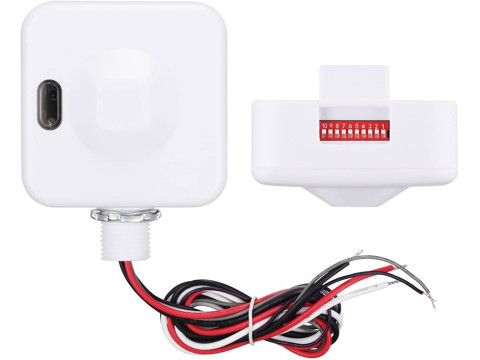A microwave motion sensor is a device that detects movement by emitting and receiving radio waves in the GHz frequency range. When an object moves within its coverage zone, the sensor interprets changes in the reflected signal (the Doppler effect) and triggers an output. In lighting applications, these sensors can automatically switch lights on when movement is detected and off after a set time. Below, we explore how these sensors work, their advantages for lighting, and a few considerations regarding their installation.
1. How Microwave Motion Sensors Work
1.1 Doppler Radar Principle
Microwave motion sensors operate on the Doppler effect:
- Transmitter (Antenna/Generator): Generates a low-power radio frequency (RF) signal—often in the 1–10 GHz range.
- Receiver: Monitors reflections of that same RF signal. When a moving object (like a person) enters the detection zone, the reflected frequency shifts slightly.
- Signal Processing: Detects this frequency shift, confirming movement. The sensor then outputs a control signal—commonly used to turn on a light or activate another device.
Since these sensors transmit at very low power, most jurisdictions do not require licensing for typical in-home or commercial usage.
1.2 Advantages over Passive Infrared (PIR)
- Insensitivity to Air Currents: Microwave sensors do not confuse convection or drafts with true motion.
- All-Weather Operation: In suitably rated enclosures, they can reliably detect movement in fog, rain, or snow.
- Penetration of Light Materials: Radio waves can pass through thin walls, plastic, or glass—both a strength and a potential drawback.
2. Microwave Motion Sensors in Lights
2.1 Built-In Microwave Sensors
Many modern lighting fixtures integrate a compact microwave sensor module inside the housing. In everyday settings:
- Ceiling Mount or Wall Mount: The sensor antenna covers a 360° (ceiling) or forward-facing (wall) detection pattern.
- Motion-Activated Switching: As soon as movement is detected, the light turns on. If no movement is detected after a set delay, the light switches off.
2.2 Pros and Cons
Pros:
- Large Coverage Area: Especially if mounted on ceilings, sensors can detect motion in wide or circular zones.
- Fewer False Alarms: Less likely than some sensors to trip from ambient temperature shifts or air flows.
- No Extra Wiring Needed: Integrated designs eliminate the need for separate sensor wiring; just wire the fixture normally.
Cons:
- Possible Detection Through Walls: Movement in an adjacent room may trigger the light if the barrier doesn’t block radio waves effectively. Careful positioning or adjusting the sensor’s sensitivity can mitigate this.
- Combined Unit: If the sensor fails, the entire fixture might not function, unless it includes a manual override.
- Requires Tuning: Sensitivity and time-delay settings should be tailored to the environment.
3. Important Features for Sensor Lights
3.1 Sensitivity Adjustment
Being able to adjust the sensor’s sensitivity lets you accommodate or reduce false triggers—particularly valuable if the sensor can detect motion in neighboring spaces.
3.2 Time-Delay Setting
A time delay ensures the light does not turn off too quickly if someone pauses motion. Most sensor-equipped lights allow users to adjust the delay anywhere from seconds to several minutes, matching the space’s needs.
3.3 Pairing with LED Lights
Microwave sensors pair ideally with LED fixtures:
- Instant On/Off: LEDs illuminate right away without warm-up.
- Energy Efficiency: Low consumption pairs well with motion-activated controls.
- Longer Lifespan: Minimizing continuous “on” time further prolongs LED longevity.
4. Installation Tips
- Placement: Position the sensor in a location with a clear line of sight to the target area. Avoid direct placement near large metal objects, which can distort or block RF signals.
- Avoid Over-Detection: If walls are thin or made of glass, signals might pass into adjacent rooms. Dial back sensitivity or use shielding materials if needed.
- Check Environmental Factors: For outdoor usage, ensure the fixture is rated for weather exposure.
- Configure Settings: Most motion fixtures allow adjusting sensitivity and time delay. Test multiple scenarios—like partial movement or slow walks—to ensure consistent activation.
Conclusion
Microwave motion sensors leverage Doppler radar technology to detect movement for automated lighting and security. Their capability to handle varying conditions—like air currents or inclement weather—makes them an excellent choice for both indoor and outdoor installations. However, their ability to detect motion through light walls can be either a feature or a drawback, necessitating careful setup.
When integrated into a lighting fixture, these sensors reduce wiring complexity and streamline usage. For the best results, look for adjustable sensitivity, time-delay controls, and pairing with efficient LEDs. To find a sensor-light solution that balances coverage, reliability, and cost, consider the guidelines above. For more tailored advice or product recommendations, safsale.com offers resources to help you harness microwave motion sensing in lighting applications effectively.

